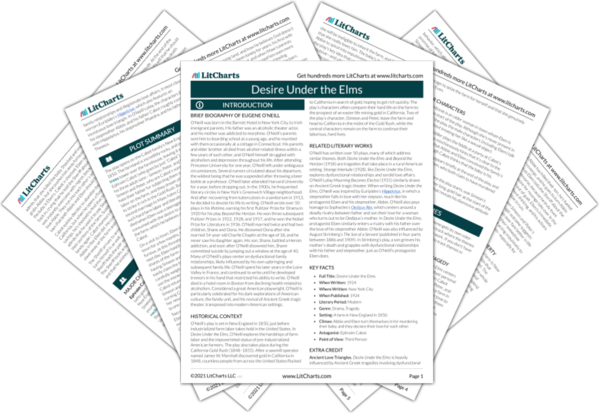In the play, the two elm trees symbolize Maw’s and Abbie’s oppressive and/or powerful maternal energy, which often goes unseen but nevertheless has a strong influence on the male characters.
Eben’s mother, Maw, dies some years before the play begins, but the play’s characters can still feel her oppressive, maternal energy looming over them—just like the elm trees that loom over the house, keeping it in perpetual shadow. Cabot, for instance, finds the energy in the house so unnerving and suffocating that he often sleeps out in the barn. (And later, he finds Abbie’s intuition so unsettling that it compels him to sleep out in the barn, too.) This is particularly striking given that Cabot is such a macho character: he proudly owns the farmhouse and surrounding farm, he’s the one who worked Maw to the death by subjecting her to such hard farm labor (at least according to Eben), he refuses to respect women, and he remembers Maw as a “dumb fool.” But Maw’s haunting presence is so heavy and palpable, much like the elm trees that “brood oppressively over the house,” that it compels Cabot to sleep in the barn like an animal rather than having the dignity of sleeping in his own home.
The stage directions at the beginning of the play read: “[The elm trees] are like exhausted women resting their sagging breasts and hands and hair on its roof, and when it rains their tears trickle down monotonously and rot on the shingles.” Given that Maw died after being worn down by a lifetime of grueling farm labor, it’s clear that the trees symbolize Maw’s exhausted, overworked spirit, which presses down on the house and weighs heavily on all who live inside. And indeed, Eben’s longing to appease Maw’s spirit and avenge her untimely death is nearly always on his mind and drives most of his behavior in the play. Thus, even in death, Maw has a strong but silent hold over the play’s two main male characters.
Cabot’s new wife, Abbie, embodies a similarly oppressive, maternal energy. Throughout the play, she works in the shadows to quietly manipulate both Cabot and Eben to achieve her own desires—even though both characters belittle, objectify, and underestimate her. The stage directions note that “There is a sinister maternity in [the elm trees’] aspect, a crushing, jealous absorption. They have developed from their intimate contact with the life of man in the house an appalling humaneness.” Here, the elm trees mirror Abbie in several ways. First, she “absor[bs]” both Cabot and Eben into her initially “sinister” plot of taking over the farm. And as she develops a genuine romantic relationship with Eben, it’s Abbie herself who becomes so “absor[bed]” by Eben, that her love for him is “crushing” and “jealous.” Like the elms that keep the farmhouse cloaked in darkness, Abbie’s obsession with Eben comes to cloud her judgment.
The stage directions describe how the elm trees that flank the house “bend their trailing branches down over the roof. They appear to protect and at the same time subdue.” Likewise, both Maw and Abbie exude a maternal energy that both nurtures and “subdue[s]” (i.e., controls, overpowers, or conquers) the men in the house. For instance, when Eben and Abbie are first physically intimate, his grief over Maw’s death intermingles with his lust for Abbie, and Abbie promises that Eben will be like a son to her—and her lover. And throughout their relationship, Abbie indeed both nurtures and controls Eben with ease, just as Maw’s memory both comforts and overpowers him. The “Two enormous elms [that] are on each side of the house” thus symbolize the strength and power that the two women in the play have over the male characters. Like the imposing elm trees, which keep the house in constant, oppressive shadow, the women in the play control the men’s environment, and they are often far stronger and more powerful than the men give them credit for.
Elm Trees Quotes in Desire Under the Elms
Two enormous elms are on each side of the house. They bend their trailing branches down over the roof. They appear to protect and at the same time subdue. There is a sinister maternity in their aspect, a crushing, jealous absorption. […] They brood oppressively over the house. They are like exhausted women resting their sagging breasts and hands and hair on its roof, and when it rains their tears trickle down monotonously and rot on the shingles.










